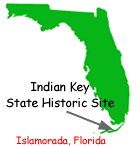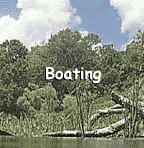
Reservations for
Florida State
Parks are now
made through
Reserve America,
toll free, at
1-800-326-3521
|
INDIAN KEY STATE HISTORIC SITE
 Indian Key is located about three-fourths of a mile in a southeasterly direction from the north shore of Lower Matecumbe Key. Only slightly more than 10 acres in size and separated from the Overseas Highway by open water, it hardly looks like a place of historic significance. Yet Indian Key has had a colorful past which is very much a part of early Florida history. It dates from the time of prehistoric Indians to the 1830s, when this small key was the seat of newly created Dade County. The foundations of buildings and cisterns on the island date back to this prosperous time. Indian Key is located about three-fourths of a mile in a southeasterly direction from the north shore of Lower Matecumbe Key. Only slightly more than 10 acres in size and separated from the Overseas Highway by open water, it hardly looks like a place of historic significance. Yet Indian Key has had a colorful past which is very much a part of early Florida history. It dates from the time of prehistoric Indians to the 1830s, when this small key was the seat of newly created Dade County. The foundations of buildings and cisterns on the island date back to this prosperous time.
EARLY HISTORY
Through archaeological excavations, it is known that Indians lived in the Keys for several thousand years before the arrival of the Spanish explorers. When Ponce de Leon discovered Florida in 1513, he found a quick way for Spanish vessels to return home with their cargo of treasure taken from the Maya, Inca and Aztec empires: the Straits of Florida and the Gulf Stream. It was a dangerous route for the cumbersome Spanish sailing vessels because of the coral reefs lining the south Florida coast and the constant threat of hurricanes. At the time, hostile Calusa Indians lived in the Keys. They became the first to profit from vessels wrecked on the offshore reefs. By the time of the brief English occupation of Florida starting in 1763, however, the Calusas had disappeared from the Keys. Bahamian fishermen and turtlers took their place, making salvage a way of life. "Wrecking" proved to be a profitable business; so lucrative, in fact, that it attracted pirates who soon became a threat to merchant vessels.
AMERICAN HISTORY
American occupation of Florida in 1821 stopped the pirates' activities. In addition, American wreckers drove the Bahamians out of business in the Keys and monopolized it themselves. Key West was the main wrecking station in south Florida and became a wealthy community from the profits of salvage. The monopoly of Key West was challenged by a man named Jacob Housman. Having arrived from Staten Island in one of his father's ships which he "borrowed," he found wrecking to his taste. After disagreements with the Key West establishment, which accused him of various shady business maneuvers, he thought it best to own his own wrecking station.
The strategic location of Indian Key, nearby fresh water on Matecumbe and proximity to the most dangerous reefs, made it ideal for Housman's plans. He bought the island in 1831 and began to build his own small empire. This included a thriving store, hotel and dwellings with cisterns, as well as warehouses and wharves. Housman turned Indian Key into a busy port with 40 to 50 permanent inhabitants. He even brought soil to the rocky island and landscaped it with tropical plants. Housman's profits from his business ventures and wrecking were substantial. Eventually, there were more disputes with the Key Westers, who again accused him of illegal conduct as a wrecker.
In an effort to make his island independent of Key West, he had the Legislative Council establish Dade County in 1836, with Indian Key as the county seat. In spite of this success Housman's fortunes began to decline. He lost numerous court battles and eventually his wrecker's license. At the outbreak of the Second Seminole War in 1835, he also lost his Indian trade. In the end, he had to mortgage the island.
In 1838, Dr. Henry Perrine, a physician with a consuming interest in tropical botany, moved to Indian Key to await the end of the war. He wanted to use a government grant to cultivate useful tropical plants on the mainland. Perrine's special interest lay in cultivating agave for the manufacture of hemp, but he also included many others, such as tea, coffee, bananas and mangos, in his plans. While waiting for the war's end, he started a nursery on Matecumbe.
As the war continued, Housman's island became an endangered outpost because of the well-stocked store and warehouses. He asked for government protection. Eventually, military forces were stationed at nearby Tea Table Key. They proved of little value, however, in the events that followed. In the early morning of August 7, 1840, a band of more than 100 Indians attacked the island. Most of the inhabitants, including Housman and his wife, managed to escape. However, some were killed in the attack and subsequent looting and burning of the buildings. Dr. Perrine hid his family in a turtle kraal below the house, where they survived the attack. He was not so fortunate. After a futile attempt to talk to the Indians, he was killed and the house set on fire.
Except for one building and the stone foundations, all the structures on Indian Key were destroyed during the attack. As the survivors learned too late, the garrisons at Tea Table Key had been reduced to five able men a few days before.
Although some of the inhabitants returned to the island after the incident, Housman did not. Instead, he sold Indian Key and returned to Key West, where he served as a crew member on a wrecking vessel. In 1841, during salvage operations in rough seas, he was accidentally crushed between two ships. Indian Key has remained uninhabited since the early part of this century. Gradually, Dr. Perrine's plants have grown over the ruins.
RESOURCES
An observation tower, boat dock, shelter and trails are provided; however, there are no restrooms or picnic facilities.
- Most facilities and activities are not accessible to the disabled. See Park Ranger for special needs.
- Ranger-guided tours are available at 9:00 a.m. and 1:00 p.m., Thursday through Monday. The tour fee is $1 per person. Children under 6 are admitted free of charge.
- Tour boat service available. For reservations please call (305) 664-9814 or 664-4196. Tour boat departs 1/2-hour before listed tour times.
- Book a guided walking tour at the MM 78.5 boat ramp. 305-664-4815.

Indian Key is located on the ocean side of U.S. 1 at M.M. 78.5. It is accessible only by private boat or charter boats available at nearby marinas.
For information, contact:
Indian Key State Historic Site
P.O. Box 1052
Islamorada, Florida 33036
(305) 664-2540
View Larger Map
|



